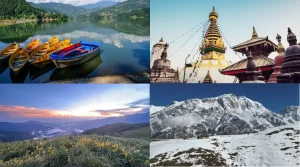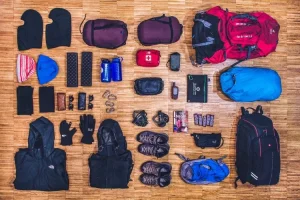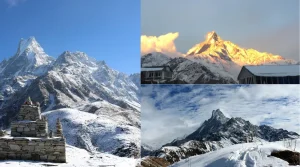Nepal is more than just a land of mountains and trekking trails, but it’s also full of stories, smiles, and traditions. Walk through old temples like Pashupatinath or Swayambhunath, and you’ll feel the peaceful energy all around. Every day life here is special too. People greet you with a warm “Namaste,” cook tasty meals like dal bhat, and celebrate colorful festivals like Dashain and Tihar with joy and music. You can see local crafts being made, join a village feast, or take part in a family’s tradition. You’ll always be welcomed with a warm smile.
In this Nepal culture guide, we explore the country’s most iconic temples, time-honored traditions, colorful festivals, and authentic experiences that make cultural tours in Nepal unforgettable.
Nepal: A Land of Living Heritage
In Nepal, culture isn’t kept behind glass or staged for show; it’s woven into daily life, and travelers are welcome to join in. You don’t just watch from the sidelines; you feel the vibration of sacred chants in the air, taste the warmth of home-cooked dal bhat, and find yourself dancing in the streets during a festival you hadn’t planned on attending. Whether it’s lighting a butter lamp in a mountaintop monastery or learning a few words of Nepali from a market vendor, the experience is hands-on. Culture here is something you live, not just look at.
Iconic Temples & Heritage Sites in Nepal

Nepal is home to some of the most spiritually and architecturally significant sites in South Asia. Spirituality is the backbone of Nepali culture, all ancient sites are visited by pilgrims from around the world. These heritage sites don’t just tell stories of the past, they’re part of Nepal’s living spiritual landscape.
Here are four iconic temples in Nepal that reflect the country’s deep religious roots:
1. Pashupatinath Temple (Kathmandu) – Sacred Hindu Pilgrimage

Pashupatinath Temple is one of the most important Hindu temples in the world. It’s in Kathmandu, Nepal, and is dedicated to Lord Shiva, one of the main gods in Hinduism. People come from all over to pray, find peace, or just experience the deep spiritual energy of this place.
The temple sits by the Bagmati River. It’s not just a place for worship, it’s also where people say goodbye to loved ones. Along the riverbanks are cremation ghats, where Hindu funerals take place in the open. It can be emotional and powerful to witness, as it shows how life and death are closely connected in this culture.
2. Boudhanath Stupa & Swayambhunath (Monkey Temple) – Buddhist Icons

Boudhanath and Swayambhunath are two of Kathmandu’s most iconic Buddhist sites.
- Boudhanath Stupa is huge, peaceful, and surrounded by prayer wheels and monks. Its big white dome and Buddha eyes watch over everything. People walk around it slowly, spinning wheels and chanting. It’s calm, even with the buzz of the city.
- Swayambhunath, or the Monkey Temple, sits on a hill. You’ll climb steep steps (and maybe meet some monkeys) to reach the top. The view of Kathmandu is amazing. The stupa is old, sacred, and full of color and prayer flags. Both places are perfect for quiet moments, reflection, or just soaking in the peaceful energy.
3. Janaki Temple (Janakpur) – A Marvel of Mithila Architecture

Stepping into Janaki Temple feels like walking into a storybook. This stunning white-and-color palace in Janakpur is dedicated to Goddess Sita who is believed to be born right here! The temple’s walls are full of art, love, and devotion. During festivals like Vivah Panchami, it lights up with music, flowers, and joy. You don’t have to be religious to feel the magic here. The beauty, the energy, the people, it justl pulls you in. Janaki Temple isn’t just a place to see, it’s a place to feel. If you’re in Nepal, don’t miss it!
4. Muktinath (Mustang) – Peace in the peaks

High in the Himalayas, Muktinath is a place where Hindus and Buddhists come together in prayer. It’s not easy to reach but that’s part of the magic. Surrounded by snow-capped mountains, this sacred spot in Mustang feels like the edge of the world. People come here to wash away sins under 108 icy water spouts and to find peace in the thin, crisp air. The temple is small, but the feeling is huge. Whether for faith or adventure, Muktinath gives you something to carry home not just in your heart, not just your camera.
Festivals That Define Nepali Culture

Festivals in Nepal aren’t just events, they’re emotional and spiritual celebrations that unite families and entire communities.
Dashain – Festival of Victory
Celebrated over 15 days in autumn, Dashain honors the victory of goddess Durga over evil. Families reunite, elders give blessings, and communities come alive with rituals.
Tihar – Festival of Lights
Often called the Nepali Diwali, Tihar celebrates animals like crows, dogs, and cows, as well as brothers and sisters. Homes are decorated with oil lamps and rangoli patterns.
Holi – Festival of Colors
A riot of color and joy, Holi marks the arrival of spring. People throw colored powder, sing, and dance in the streets.
Buddha Jayanti – Honoring Lord Buddha
Celebrated on the full moon day of May, this festival marks the birth, enlightenment, and death of Buddha, with prayer gatherings, candle lighting, and processions across the country.
Traditional Practices & Local Rituals

Nepal’s spiritual life is filled with unique customs you won’t find anywhere else.
Kumari – The Living Goddess
In Kathmandu, a young girl is revered as a living incarnation of the goddess Taleju. Witnessing the Kumari during festivals like Indra Jatra is a rare and moving experience. Seeing the newari community engrave their culture and take on the responsibility is a heart waming moment.
Daily Puja Rituals
In temples across the country, devotees perform daily puja (worship), offering flowers, incense, and prayers to deities. Its a form of self reflection and realization for the believers because you can lie to everyone but the almighty god.
Prayer Wheels and Mantras
In Buddhist regions, spinning mani wheels and chanting “Om Mani Padme Hum” are common rituals believed to bring peace and compassion. Just spinning some holy wheels can give devotees the feeling of peace and calm. And those are spiritual and religious values of Nepali culture.
Cultural Experiences for Travelers

Traveling in Nepal is more than just city life, it’s the wrap that makes you want to stay here forever, the warmth of the people, the culture, the religious values, the belief in God, and the sincerity of Nepali people. Here are some ideas if you want to go beyond sightseeing and immerse yourself in Nepali culture:
Homestays in Ethnic Villages
Live with local families in Gurung, Tamang, or Tharu villages. Learn farming techniques, taste homemade raksi (rice wine), and enjoy genuine hospitality. Villages are a must-visit places if you want to feel and experience the authentic Nepali life.
Cooking Classes and Food Tours
Nepali cuisine is flavorful and diverse. Join a cooking class to learn how to make momos, dal bhat, and sel roti, or explore street food in Kathmandu with a local guide. You can try different cuisines of different ethnic group of the country, as each community has its own specialty.
Traditional Dance & Music Performances
From Newar masked dances to Tamang Selo folk songs, cultural shows offer a window into Nepal’s artistic soul. Each district of Nepal has its own traditional activities that showcase their love and respect toward their own cultural values.
Understanding Nepal’s Ethnic Diversity

Nepal is home to over 142 ethnic groups and more than 120 languages, making it a mosaic of identities and cultures. The fun and interesting part of this diversity is that each group/community has its own rituals, traditions, and ethical wears. To each their own. But the fact that all these various cultures and values never collide or go against each other shows the true virtue of Nepal, and the respect and endurance people have for others around them.
Here are a few prominent communities:
- Newar – Indigenous to the Kathmandu Valley; known for art, architecture, and festivals. One of the communities that stil follows the traditional ways of celebrating rituals and festivals.
- Gurung & Tamang – Found in hilly regions; strong in tradition, music, and communal life.
- Sherpa – Highlanders, famed for their mountaineering skills and Buddhist faith. Known for their high endurance towards the harsh climate in the mountains.
- Tharu – Inhabiting the Terai lowlands; known for their distinct customs, homes, and dances. They never let their culture and virtues fade.
Each group offers unique ways of life worth exploring
Responsible Cultural Tourism Tips
To engage meaningfully and respectfully with Nepali traditions, keep these tips in mind:
Do’s:
- Ask before photographing people or sacred sites
- Dress modestly, especially in temples and rural areas
- Learn a few basic Nepali phrases like Namaste and Dhanyabad (thank you)
Don’t:
- Point your feet at people or religious objects
- Enter temples with shoes on or without permission
- Assume all Nepalese people follow the same customs, diversity is the rule, not the exception
Conclusion: How Culture Enriches the Nepal Experience
Exploring Nepal through its culture is one of the most rewarding ways to understand this incredible country. Whether you’re meditating at a centuries-old stupa, dancing with locals during Tihar, or sharing a meal in a mountain village, Nepal’s cultural richness adds heart and soul to your journey.
Exploring one of the most beautiful countries with numerous cultures, communities, and languages, Nepal offers the values that a good travel place should have, from the highest peak in the world to the total plains of Terai rich in agriculture. Nepal never disappoints when it comes to traveling, experiencing new cultures, meeting new people, and exploring the unexplored.




